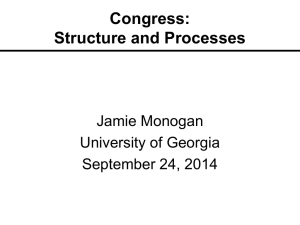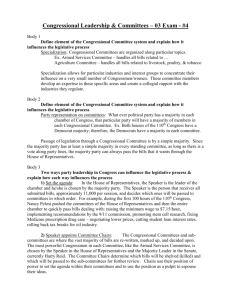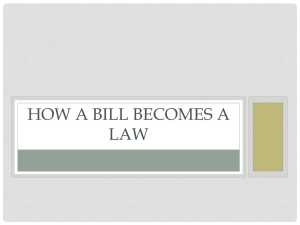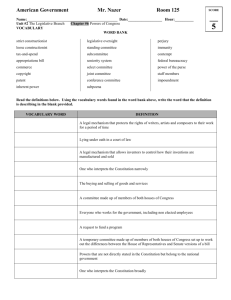Congress Notes 3 - Fulton County Schools
advertisement
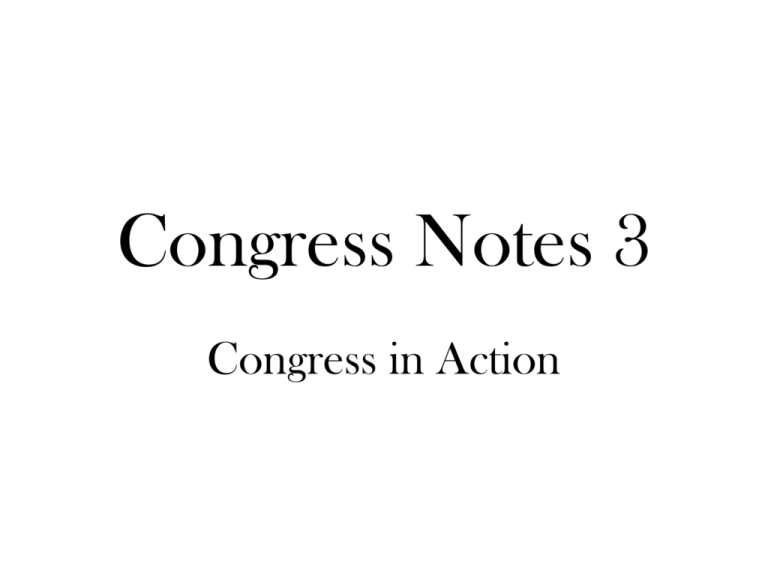
Congress Notes 3 Congress in Action Congressional Organization • Congress convenes on January 3rd of every odd numbered year • There are a variety of important events that occur on opening day in the Senate and the House such as election of officers and the administration of oaths of office • The presiding officer of the house is known as The Speaker of the House • S/He is the most powerful (wo)man in the House of Representatives • S/He is the elected presiding officer of the House and the acknowledged leader of the majority party • Her/His primary duties are to preside and keep order during session • S/He may not debate issues and preside over the house at the same time • S/He follows the Vice President in the line of succession to the Presidency • The Vice president is the leader of the Senate, however he does not take as active a role in the day to day operations of Congress as the Speaker of the house • Underneath the presiding officers in congress are the party floor leaders and the whips • These positions are meant to serve as tools for the political parties to operate within the activities of congressional session • The party caucus is the meeting between members of one of the two political parties to discuss party organization • One of the most important jobs of the majority caucus is choose committee chairman • Seniority Rule: That the senior members of the party will take the ranking posts that are available • Many critics believe that this system ignores talent and ability and does not result in the best possible person actually filling the post Congressional Committees • A standing committee is a permanent committee that focuses its efforts on legislation in a specific area ex: Agriculture, Budget, National Security • The House Committee on Rules is the committee that screens bills before they reach the floor, they can speed, delay, or even prevent a bill from reaching the floor • Select committees are set up for a limited amount of time to deal with a specific issue, often times they are used to investigate a current issue that congress needs information on • Joint committees are made up of members of both houses in order to not have committees in the house and the senate that duplicate each others work • A conference committee is set up to make sure that a bill being voted on is uniform and agreeable to both houses of congress How a Bill Becomes a Law • • • • • • • • Most bills begin as a need or request outside the legislative branch Bills, both public and private are presented to the House or Senate for enactment into law Joint resolutions are similar to bills, however they deal with unusual or temporary matters Concurrent resolutions are put forth by both houses but are not signed off on by the President, hence forth not giving them the strength of a law Resolutions are brought up in one house or the other and often deal with matters exclusive to the operation of the House or the Senate Many bills contain Riders, which are provisions that are not likely to pass on their own, so they are attached to something more important with the hopes that it will be pushed through Congressional committees are often so bogged down with bills that they are split into subcommittees to examine bills dealing with specific issues There are a number of procedures and rules that the House deals with in the presentation, debate, and passing of a bill • Resolutions are brought up in one house or the other and often deal with matters exclusive to the operation of the House or the Senate • Many bills contain Riders, which are provisions that are not likely to pass on their own, so they are attached to something more important with the hopes that it will be pushed through • Congressional committees are often so bogged down with bills that they are split into subcommittees to examine bills dealing with specific issues • There are a number of procedures and rules that the House deals with in the presentation, debate, and passing of a bill Bills in the Senate • Bills are introduced by Senators who are formally recognized for that purpose • Senatorial debate over legislation is often unrestrained and can on for long periods of time • Some senators try to filibuster, or talk a bill to death in an attempt to stall to the point where the bill is dropped • There is the rule of Cloture which attempts to stop filibustering and limit debate, however it is so difficult to invoke that it is largely ignored Committees in Congress • Congress does much of its work in committees. • Standing committees are the permanent committees in both houses. • The Senate has 17 standing committees and the House has 19; the other types of committees are: • select–special, often temporary bodies • joint–usually permanent, made up of members of both houses • conference–temporary, joint committees formed to work out differences in Senate- and House-passed measures. Bills and the President • The last step in making a bill into law is the approval of the President • When a bill reaches his desk he has 4 options • He can sign it and it becomes law • He may veto it and it goes back to the Congress or dies • He may allow the bill to become law by not signing it within 10 days • He may use a pocket veto, if Congress adjourns within ten days of presenting the bill and he does not sign it then it will die • – Veto literally translated means “ I Forbid”.


